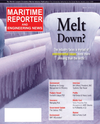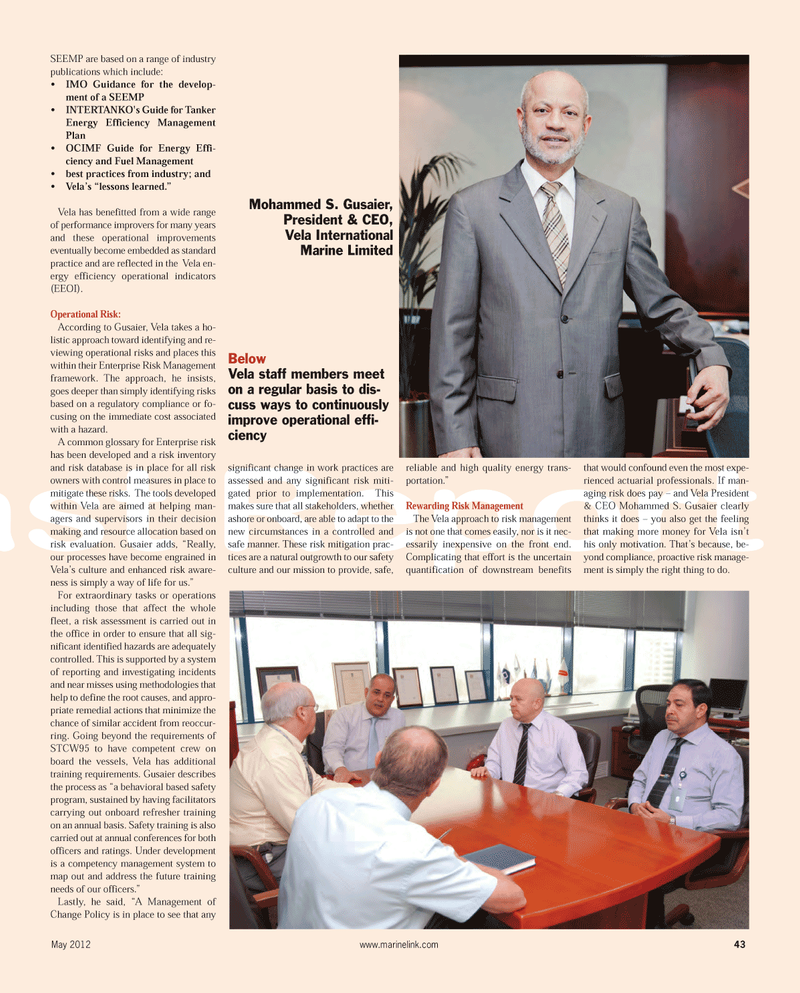
Page 43: of Maritime Reporter Magazine (May 2012)
The Green Ship Edition
Read this page in Pdf, Flash or Html5 edition of May 2012 Maritime Reporter Magazine
ast Report May 2012www.marinelink.com 43SEEMP are based on a range of industrypublications which include: IMO Guidance for the develop- ment of a SEEMPINTERTANKO's Guide for Tanker Energy Efficiency Management PlanOCIMF Guide for Energy Effi- ciency and Fuel Managementbest practices from industry; and Vela?s ?lessons learned.? Vela has benefitted from a wide range of performance improvers for many years and these operational improvements eventually become embedded as standard practice and are reflected in the Vela en- ergy efficiency operational indicators (EEOI).Operational Risk:According to Gusaier, Vela takes a ho- listic approach toward identifying and re- viewing operational risks and places this within their Enterprise Risk Managementframework. The approach, he insists, goes deeper than simply identifying risksbased on a regulatory compliance or fo- cusing on the immediate cost associatedwith a hazard. A common glossary for Enterprise riskhas been developed and a risk inventory and risk database is in place for all riskowners with control measures in place to mitigate these risks. The tools developed within Vela are aimed at helping man- agers and supervisors in their decisionmaking and resource allocation based onrisk evaluation. Gusaier adds, ?Really, our processes have become engrained in Vela?s culture and enhanced risk aware- ness is simply a way of life for us.? For extraordinary tasks or operations including those that affect the whole fleet, a risk assessment is carried out inthe office in order to ensure that all sig- nificant identified hazards are adequately controlled. This is supported by a system of reporting and investigating incidents and near misses using methodologies thathelp to define the root causes, and appro- priate remedial actions that minimize thechance of similar accident from reoccur- ring. Going beyond the requirements of STCW95 to have competent crew on board the vessels, Vela has additional training requirements. Gusaier describesthe process as ?a behavioral based safety program, sustained by having facilitators carrying out onboard refresher trainingon an annual basis. Safety training is alsocarried out at annual conferences for bothofficers and ratings. Under development is a competency management system to map out and address the future trainingneeds of our officers.? Lastly, he said, ?A Management of Change Policy is in place to see that any significant change in work practices are assessed and any significant risk miti- gated prior to implementation. This makes sure that all stakeholders, whether ashore or onboard, are able to adapt to thenew circumstances in a controlled and safe manner. These risk mitigation prac- tices are a natural outgrowth to our safety culture and our mission to provide, safe, reliable and high quality energy trans- portation.? Rewarding Risk ManagementThe Vela approach to risk management is not one that comes easily, nor is it nec- essarily inexpensive on the front end. Complicating that effort is the uncertain quantification of downstream benefits that would confound even the most expe- rienced actuarial professionals. If man-aging risk does pay ? and Vela President & CEO Mohammed S. Gusaier clearlythinks it does ? you also get the feelingthat making more money for Vela isn?t his only motivation. That?s because, be- yond compliance, proactive risk manage- ment is simply the right thing to do.Mohammed S. Gusaier, President & CEO, Vela International Marine LimitedBelowVela staff members meet on a regular basis to dis-cuss ways to continuouslyimprove operational effi- ciencyMR May 12 # 6 (42-49):MR Template 5/7/2012 2:51 PM Page 43

 42
42

 44
44
